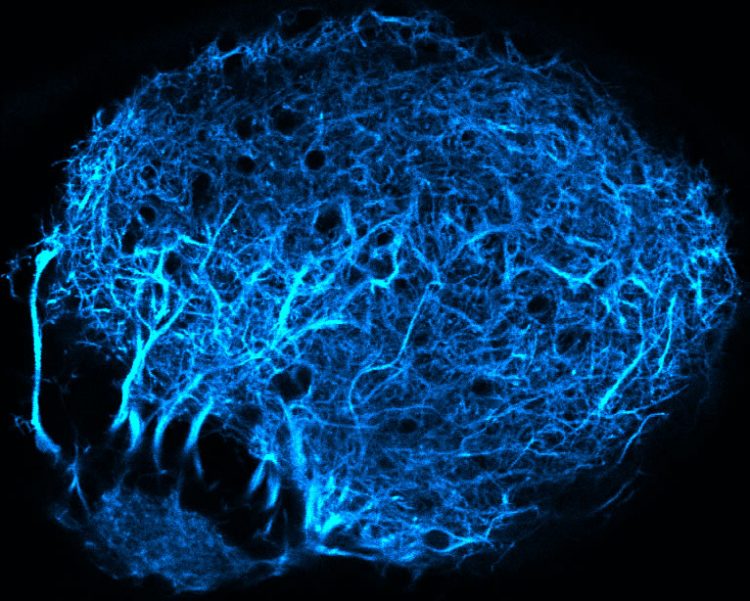Fish on the run

The zebrafish tectum recognizes an approaching object as a threat. This brain area is innervated by axons from the eye (stained blue). © Max Planck Institute of Neurobiology / Temizer
Humans and animals instinctively evade rapidly approaching objects. By doing so, they avoid collisions or escape attacking predators. For this to happen, the brain must calculate the direction and speed of a stimulus in the visual system and initiate an appropriate evasive reaction.
How the brain achieves this is largely unclear. Scientists from the Max Planck Institute of Neurobiology in Martinsried have now shown in zebrafish larvae what is interpreted as an approaching foe and which area of the brain recognizes an object as a threat and initiates a flight reaction.
Duck! In most cases, this warning is not necessary when we see an object approaching on collision course. Whether in a fly, fish, mouse or human, such situations generally trigger a stereotypical evasive reaction. In this way, potential predators or injury can be avoided.
“Because this behaviour is so similar across the entire animal kingdom, there is probably a hardwired programme for it in the brain,” says Incinur Temizer, summarizing the essence of her doctoral dissertation. In Herwig Baier’s Department at the Max Planck Institute of Neurobiology, she is studying, based on this example, how the brain converts sensory impressions into behavioural responses.
Incinur Temizer and her colleague Julia Semmelhack have now shown that zebrafish larvae measuring just a few millimetres in length flee from a two-dimensional representation of an object moving towards them. To pinpoint the location of the responsible circuit in the brain, the scientists first determined what exactly triggers the flight reflex.
In a series of experiments, they showed the fish a range of objects that differed in size, brightness and speed. The results showed that the flight reflex is most reliably triggered by a dark disc that “looms”, meaning that it gradually increases in size.
The researchers then used optical methods to measure brain activity in response to this “key stimulus”. This is possible, as the tiny fish larvae are completely transparent. Thanks to a genetic modification, the brain areas that are active fluoresce under a microscope. In this way, the scientists were gradually able to narrow down the precise area of the brain that recognizes an approaching enemy and triggers a flight reflex.
The image of a looming object on the retina activates highly specific ganglion cells, which then relay the information to an area in the fish’s brain known as the tectum. The tectum assigns objects to a location in visual space and coordinates movement towards or away from such objects.
“We were able to show, for the first time, that neurons in the retina recognize an approaching object and trigger an evasive reaction through links to the tectum,” says Julia Semmelhack, summarizing the findings of the recently published study. That the tectum is really critical became clear when the researchers cut off the input of these retinal ganglion cells: such fish larvae were not entirely blind but no longer responded to approaching objects.
Contact
Dr. Stefanie Merker
Max Planck Institute of Neurobiology, Martinsried
Phone: +49 89 8578-3514
Email: merker@neuro.mpg.de
Prof. Dr. Herwig Baier
Max Planck Institute of Neurobiology, Martinsried
Phone: +49 89 8578-3200
Fax: +49 89 8578-3208
Email: hbaier@neuro.mpg.de
Original publication
Incinur Temizer, Joseph Donovan, Herwig Baier, Julia Semmelhack
A visual pathway for looming-evoked escape in larval zebrafish
Current Biology, 25 June 2015
Media Contact
All latest news from the category: Life Sciences and Chemistry
Articles and reports from the Life Sciences and chemistry area deal with applied and basic research into modern biology, chemistry and human medicine.
Valuable information can be found on a range of life sciences fields including bacteriology, biochemistry, bionics, bioinformatics, biophysics, biotechnology, genetics, geobotany, human biology, marine biology, microbiology, molecular biology, cellular biology, zoology, bioinorganic chemistry, microchemistry and environmental chemistry.
Newest articles

Properties of new materials for microchips
… can now be measured well. Reseachers of Delft University of Technology demonstrated measuring performance properties of ultrathin silicon membranes. Making ever smaller and more powerful chips requires new ultrathin…

Floating solar’s potential
… to support sustainable development by addressing climate, water, and energy goals holistically. A new study published this week in Nature Energy raises the potential for floating solar photovoltaics (FPV)…

Skyrmions move at record speeds
… a step towards the computing of the future. An international research team led by scientists from the CNRS1 has discovered that the magnetic nanobubbles2 known as skyrmions can be…





















